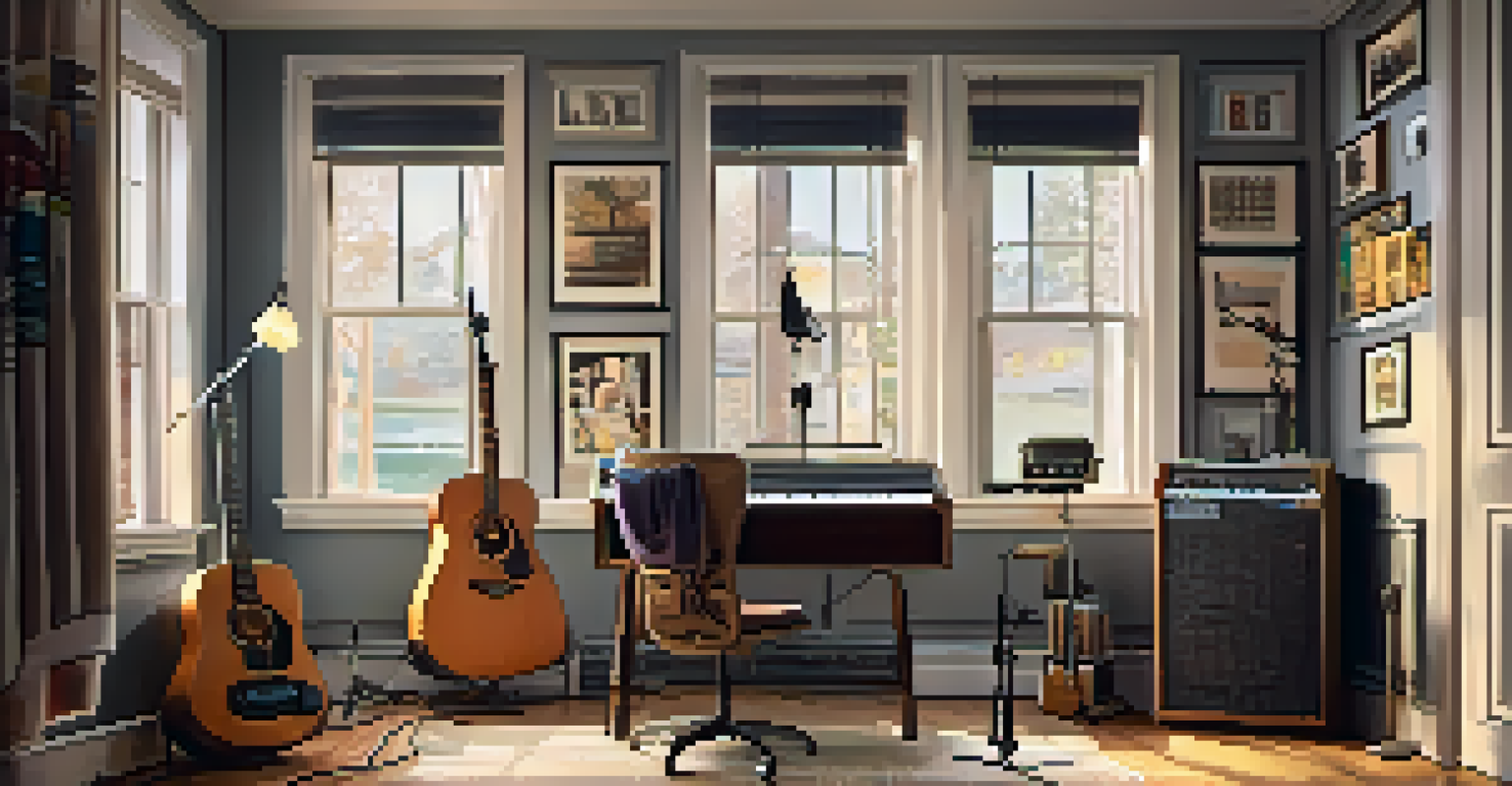How to Choose the Right Microphones for Guitar Recording

Understanding Different Types of Microphones
When it comes to recording guitars, understanding the different types of microphones is crucial. The two main categories are dynamic and condenser microphones. Dynamic mics are great for high-volume sources like electric guitars, while condensers excel in capturing the nuances of acoustic guitars.
The microphone is a transducer, which means it converts one form of energy into another. In the case of microphones, they convert sound waves into electrical signals.
For instance, if you’re recording an electric guitar amp, a dynamic microphone like the Shure SM57 is often a go-to choice. On the other hand, if you’re looking to capture the warm tones of an acoustic guitar, a condenser mic such as the Audio-Technica AT2020 might be more suitable.
Each type of microphone has its unique characteristics that affect how your guitar sounds in a recording. By understanding these differences, you can make a more informed choice tailored to your specific recording needs.
Considering Frequency Response
Frequency response refers to the range of frequencies a microphone can capture, and it's essential for guitar recording. Guitars typically produce a wide range of frequencies, so selecting a microphone with an appropriate frequency response is vital for capturing the full sound.

For example, a microphone with a frequency response tailored to emphasize the mid to high frequencies will bring out the clarity and articulation in your guitar playing. Conversely, a mic that doesn't cover the lower frequencies might miss the richness of your sound.
Choose the Right Mic Type
Understanding the differences between dynamic and condenser microphones is essential for achieving the best sound for your guitar recordings.
When choosing a microphone, check its frequency response chart to ensure it aligns with the tonal qualities you want to capture in your guitar recordings.
Microphone Polar Patterns Explained
Polar patterns determine how a microphone picks up sound from different directions. The most common patterns are cardioid, omnidirectional, and figure-eight. For guitar recording, cardioid mics are often preferred because they focus on sound coming from the front while rejecting noise from the sides.
Good sound is half the performance.
If you're in a controlled studio environment, an omnidirectional mic can capture a more natural sound by picking up all surrounding audio. However, in a noisy setting, a cardioid pattern will help isolate your guitar, ensuring that the recording remains clean and clear.
Understanding polar patterns helps you choose a microphone that will best suit your recording environment and needs, allowing for a more polished final product.
Choosing Between Dynamic and Condenser Mics
Deciding between dynamic and condenser microphones can significantly influence your guitar recordings. Dynamic microphones are typically more rugged and can handle high sound pressure levels, making them ideal for live performances and loud instruments.
On the other hand, condenser microphones are more sensitive and can capture a wider range of frequencies, making them ideal for studio recordings where clarity and detail are paramount. For instance, if you want to capture the subtle nuances of fingerpicking on an acoustic guitar, a condenser mic would likely serve you better.
Frequency Response Matters
Selecting a microphone with the appropriate frequency response ensures that you capture the full tonal range of your guitar.
Ultimately, the choice between these two types depends on your recording context and the sound you aim to achieve, so consider the pros and cons of each.
Budgeting for Your Microphone Choice
Budget is always a key consideration when selecting microphones for guitar recording. Fortunately, there are great options available across various price ranges. While high-end microphones can offer exceptional sound quality, there are also many affordable mics that provide excellent value.
For instance, the Shure SM57 is a classic dynamic mic that’s both budget-friendly and widely respected in the music industry. On the other hand, entry-level condensers like the MXL 990 are great for home studios without breaking the bank.
By setting a realistic budget, you can explore a range of microphones that fit your financial constraints while still meeting your recording needs.
Testing Microphones in Real Scenarios
Before making a final decision, it's beneficial to test microphones in real recording scenarios. If possible, visit a music store where you can try out different mics with your own guitar. This hands-on experience can reveal how each microphone captures your playing style and tone.
Consider recording the same guitar part with different microphones to compare the results. Pay attention to how each mic responds to your playing dynamics and the overall tonal quality.
Test Before You Invest
Testing microphones in real scenarios allows you to find the best fit for your unique playing style and recording environment.
Testing microphones allows you to make a more informed choice, ensuring that you pick the right one for your unique sound and recording environment.
Additional Accessories for Guitar Recording
In addition to microphones, certain accessories can enhance your guitar recording setup. Microphone stands, pop filters, and shock mounts can improve the quality of your recordings by stabilizing the microphone and preventing unwanted noise.
Using a good quality audio interface is also essential, as it converts your analog signals into digital ones that your computer can process. This ensures your recordings maintain their sound integrity and clarity.

By investing in these accessories alongside your microphone, you’ll create a more professional recording environment and ultimately achieve better results.
Conclusion: Finding Your Perfect Match
Choosing the right microphone for guitar recording is a blend of understanding your needs and experimenting with different options. By considering factors such as microphone type, frequency response, polar patterns, and your budget, you can narrow down your choices.
Remember, the best microphone is one that complements your unique style and fits your recording environment. Don’t hesitate to invest time in testing and exploring various microphones to find the one that resonates with you.
Ultimately, the right microphone will help you capture the essence of your guitar playing, allowing your music to shine through in every recording.